
Flounders are a group of flatfish species. They are demersal fish, found at the bottom of oceans around the world; some species will also enter estuaries.

A flatfish is a member of the ray-finned demersal fish order Pleuronectiformes, also called the Heterosomata, sometimes classified as a suborder of Perciformes. In many species, both eyes lie on one side of the head, one or the other migrating through or around the head during development. Some species face their left sides upward, some face their right sides upward, and others face either side upward.

Pleuronectidae, also known as righteye flounders, are a family of flounders. They are called "righteye flounders" because most species lie on the sea bottom on their left sides, with both eyes on their right sides. The Paralichthyidae are the opposite, with their eyes on the left side. A small number of species in Pleuronectidae can also have their eyes on the left side, notably the members of the genus Platichthys.
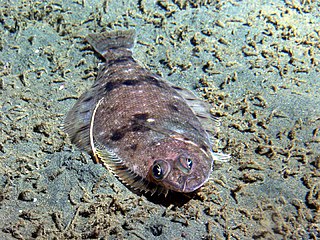
The Pacific Dover sole, also called the slime sole or slippery sole, is a Pacific flatfish of the flounder family which ranges from Baja California to the Bering Sea. It takes its name from a resemblance to the common sole of Europe, which is often called Dover sole.

Sole is a fish belonging to several families. Generally speaking, they are members of the family Soleidae, but, outside Europe, the name sole is also applied to various other similar flatfish, especially other members of the sole suborder Soleoidei as well as members of the flounder family. In European cookery, there are several species which may be considered true soles, but the common or Dover sole Solea solea, often simply called the sole, is the most esteemed and most widely available.
Dover sole refers to two species of flatfish:
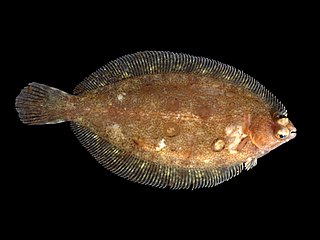
The lemon sole is a flatfish of the family Pleuronectidae. It is native to shallow seas around Northern Europe, where it lives on stony bottoms down to depths of about 1,400 metres (4,600 ft). It grows up to 65 centimetres (26 in) in length and reaches about 19 kilograms (42 lb) in weight.

The common sole, Dover sole, or black sole is a species of flatfish in the family Soleidae. It is one of the largest fish in the Solea genus. It lives on the sandy or muddy seabed of the northern Atlantic and the Mediterranean Sea where it often partially immerses itself in the substrate. The upper side is greyish-brown while the underside is white. It grows to a maximum length of about 70 cm (28 in). The species is prized as a food fish, being caught mostly by trawling on the seabed.
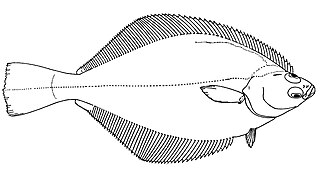
The English sole is a flatfish of the family Pleuronectidae. It is a demersal fish that lives on sandy and muddy bottoms in estuaries and near shore areas, at depths of up to 550 metres (1,800 ft). It reaches up to 57 centimetres (22 in) in length, and can weigh up to 1.5 kilograms (3.3 lb). Its native habitat is the Eastern Pacific, stretching from the coast of Baja California in the south to the Bering Sea in the north.

Limanda is a genus of righteye flounders native to the northern Atlantic and Pacific oceans.
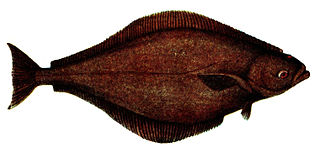
Hippoglossus is a genus of very large righteye flounders with one species native to the north Atlantic Ocean and one to the north Pacific Ocean.
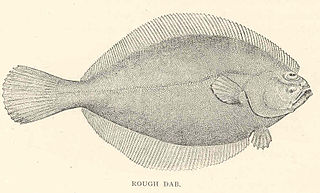
Hippoglossoides is a genus of righteye flounders native to the North Pacific and North Atlantic oceans.
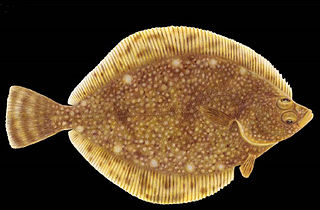
Lepidopsetta is a genus of righteye flounders native to the North Pacific Ocean.

The Pacific sand sole, also known as simply sand sole, is a flatfish species inhabiting the northeastern Pacific waters where it lives on sandy bottoms. The only species in the genus, Psettichthys, it ranges from the Bering Sea to Northern California.

The slime flounder is a kind of flatfish from the family Pleuronectidae. It is a demersal fish that lives on sand and mud bottoms at depths of between 15 and 800 metres, though it is most commonly found between 20 and 610 metres. Its native habitat is the temperate waters of the northwest Pacific, from the East China Sea to the Yellow Sea and the Sea of Japan, as far as Sakhalin and the Kuril Islands. It reaches up to 60 centimetres (24 in) in length, and can weigh up to 1.76 kilograms (3.9 lb).

Bothus is a genus of flatfish in the family Bothidae from the Pacific, Indian and Atlantic Oceans. Some species in this genus have spots consisting of blue rings.

The scaldfishes comprise a genus, Arnoglossus, of lefteye flounders. They are found in the Pacific, Indian and Atlantic Oceans, including the Mediterranean and Black Sea. They are entirely absent from most of the Americas; the only exceptions are A. coeruleosticta and A. multirastris found off Chile. The genus include both species found in shallow and deeper water. The largest species reaches 28 cm (11 in).

Etropus is a genus of large-tooth flounders native to the coastal waters of the Americas.
















